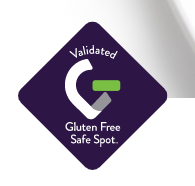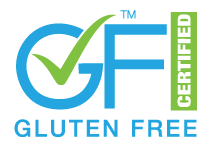
One of the hardest parts about having celiac disease is eating out.
I had never realized how much eating out was a part of my life until I could no longer eat gluten free, and after I had to experience the sometimes shameful experience of ordering a gluten-free meal at a restaurant.
While eating out makes you feel normal and allows you to spend time with your friends and family, it’s also fraught with anxiety and risk.
It’s difficult to know which restaurants you can trust, and are truly “celiac-friendly restaurants,” and which restaurants are just saying they offer gluten free options simply to make a quick buck off the gluten-free trend but are not really interested in truly serving its celiac patrons (i.e. Panera, Snooze, Cheesecake Factory, etc.).
There is so much confusion in terminology too. Some restaurants call their menus, “gluten-free friendly” while others say “gluten sensitive” or my least favorite, “gluten conscious menu.”
Very rarely do you see a “celiac menu,” or even a true-blue “gluten-free menu” these days. This ambiguity can make someone on the gluten-free diet feel very uncomfortable eating out.
On top of that, restaurant staff may feel ill-prepared and ill-equipped to field questions from their gluten-free customers, often giving incorrect information and/or raising red flags with customers they should have been able to easily serve and satisfy.
How a Third-Party Certification Benefits a Restaurant
There are several third-party organizations that not only certified products as gluten free, but also certify restaurants as gluten free too. These organizations can give restaurants an edge in a number of ways.
Instills Trust in the Restaurant: A third-party certification instills trust in that restaurant among the gluten-free community, something lacking in the current state of food service. The GIG says that 80% of gluten-free people say they feel safer eating at a restaurant that has been third-party certified gluten free.
Can Make the Restaurant More Profitable: Restaurants, more often than not, will profit from this validation. Remember, the person with the gluten disorder is often the one deciding where the entire family dines. Plus, the GIG says that 95% of gluten-free diners would be likely to try a new restaurant if they knew it was certified gluten free.
According to the GIG, 1 in 3 U.S. households say a family member eats gluten free. This means 13 percent of the US population and more than 42 million people are looking for safe gluten-free options at restaurants.
Stave Off Bad Reviews: It’s just good business practice. There’s a lot to know about serving the gluten-free community, and these third-party certifying organizations can help restaurants do gluten free right and avoid PR disasters, lawsuits and a slew of bad reviews online.
Third-Party Certifying Agencies
There are several organizations that offer a certified gluten free or third-party validation to restaurants that make the celiac-safe or celiac-friendly restaurants. They include:
(1) GFF Food Service Validation Program
GFF Food Service is a program of the Gluten Intolerance Group, a non-profit organization that also is the largest third-party gluten-free products certifying agency in the U.S. The GFF Food Service division says it is offering restaurants the opportunity to earn an independent verification of quality, integrity and purity when it comes to serving gluten-free food.
Restaurants that go through the GFF Food Service Validation Program can add the Validated Gluten Free Safe Spot logo to their menus, websites and other marketing materials.

To find a restaurant that has been validated gluten-free safe, visit gffs.org/safe-spots/ and look for the following logo. The program is currently only available in the U.S., Canada and Japan.
Right now, restaurants such as California Pizza Kitchen, The Melting Pot, BIBIBOP Asian Grill, and The Village Tavern are on the sparse list of certified gluten-free restaurants. The organization also certifies Green Chef and Freshly meal prep kits.
(2) Gluten-Free Food Program (GFFP)
The Gluten-Free Food Program is funded by the National Celiac Association and is another organization that offers restaurants the opportunity to become certified gluten free.
The organization writes on its website that it provides restaurants with the framework for creating safe gluten-free food, including training, standards, best operating practices and third-party verification audits.
The National Celiac Association, Canadian Celiac Association and la Fondation québécoise de la maladie coeliaque Association all endorse the GFFP.
You can use the organization’s GF Finder tool to search for certified gluten-free restaurants near you. The list is inclusive of bakeries, camps, restaurants, hotels, food trucks, educational institutions, and catering services, although the list is sparsely populated at best.

(3) GREAT Gluten-Free Kitchens
GREAT Gluten-Free Kitchens is a project from Beyond Celiac to help people with celiac disease find restaurants that are safe for them to solicit.
GREAT Kitchen restaurants have taken the Beyond Celiac the pledge, which requires them to undergo staff training and implement safe gluten-free protocols.
When visiting a restaurant or food establishment, look for the GREAT Kitchen logo on the door, menu, or website.

As of January 2022, GREAT Kitchen restaurants include:
- Arooga’s (Uncasville, CT; Camp Hill, Hanover, Harrisburg, Hummelstown, Lancaster,Mechanicsburg, York, Shippenburg, PA; Warwick, RI; Attleboro, MA; Patchogue,Rockville Centre, NY; East Brunswick, North Plainfield, NJ; Winter Park, FL)
- The Berghoff (Chicago, IL)
- Cactus Modern Mexican & Cantina (Lincoln, NE)
- Children’s Hospital Colorado (Aurora, CO)
- Drexelbrook Catering & Special Event Center (Drexel Hill, PA)
- For His Temple (West Monroe, LA)
- Fresh First (Fort Lauderdale, FL)
- Graffiti, Graffiti Earth (New York City, NY)
- The Happy Mixer (Chalfont, PA; Langhorne, PA)
- La Rosa’s (Columbus, OH)
- Minsky’s Pizza (Kansas City, Liberty, Independence and Blue Springs, MO, Lawrence, Shawnee, Lenexa, Prairie Village and Olathe, KS)
- Piedmont Bistro (Lincoln, NE)
- Shuck’s Fish House & Oyster Bar (Omaha, NE)
- TaMolly’s Mexican Restaurant (Abilene, Greenville, Texarkana, Paris,Waxahachie, TX, Arkadelphia, Bryant, Jonesboro, Paragould, AR, and Bossier City, LA)
- Venue Restaurant and Lounge (Lincoln, NE)
- Wilson Creek Winery (Temecula, CA)
Visit the GREAT Gluten-Free Kitchen website to see an updated list of accredited restaurants.
(4) Non-Certified-but-Dedicated Gluten-Free Restaurants
A lot of restaurants do not undergo a gluten-free certification process, but they are dedicated gluten-free businesses.
The CeliacMD has a searchable database of 100% gluten-free restaurants, and you can put in a city/state (or international destinations), and it will list restaurants that are dedicated gluten free regardless if they are validated or certified gluten free. When I searched for a list of dedicated gluten-free restaurants in Denver, the list looked accurate and inclusive.
Please be sure to support these certified and validated gluten-free restaurants, as well as dedicated gluten-free establishments.
However, never assume you will get a safe meal just because a restaurant is certified gluten free. I learned this lesson after eating at California Pizza Kitchen.
- Always have a direct conversation with the server, manager and/or chef about how they can create a safe meal for you.
- Express how serious you are about eating gluten free and how gluten makes you sick.
- Ask the right questions about ingredients, preparation and the potential for cross contamination.
- Never assume.
The restaurants that treat you right and are making an effort to serve the gluten-free community are the establishments where you should dine and spend at the most. Speak with your wallets and give support to those restaurants and food establishments that do it right and truly support the celiac community.
For more information on eating out gluten free, please download my ebook, The Ultimate Guide to Eating Out Gluten Free.
Additional Reading
300+ Gluten-Free Bakeries in the U.S.
Survey Reveals ‘Eating Out Safely’ as the Top Challenge Facing the Gluten-Free Community
10 Tips to Eating Gluten Free Frugally